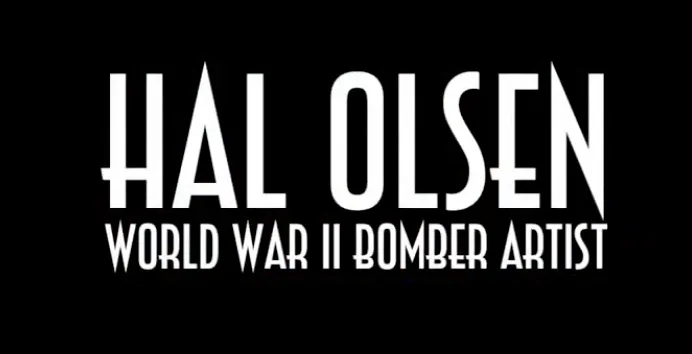History
Hopefully this offends nobody, but it’s a historical reflection of attitudes regarding wartime nose art about 70 years ago.
Hal Olsen
Hal Olsen was the last World War II nose artist who lived in Albuquerque, New Mexico. He is my wife’s first cousin once removed – the son of her maternal grandfather’s brother (or her mother’s uncle’s son). He was a U.S. Navy aviation mechanic for autopilots who also worked at Los Alamos National Lab as an artist for official bomb designs.
Nose art
He painted over 100 nose art pin-up ladies on various planes in the Pacific Theater of Operations during his stint with the US Navy during World War II on Tinian in the Northern Mariana Islands in the southwest Pacific Ocean, now a U.S. territorial commonwealth.
He charged $50 per painting and it because so popular that he made enough money for a honeymoon when he got married, as well as paying for art school. He was doing about two a day during the period from June – August 1945 (right around the time that I was born).
Tinian bombers
He painted his nose art on over 100 PB4Y-1 (Navy version of B-24) and B-29 Superfortress bombers while stationed on Tinian island; they appeared in the first color issue of the National Geographic magazine.
Some of his most famous paintings were on the Enola Gay and Bochscar, which were the B-29 bombers involved in the atomic bomb drops on Hiroshima and Nagasaki in August 1945 that ended the war six days later after the Japanese surrendered.
The final painting he made was Enola Gay because the Air Force “wanted her done right”. He had also painted a B-29 bomber named “Up-an-Atom” that became the title of his book.
Up an’ Atom
My oldest son wanted Hal’s book “Up an’ Atom” (2012) for Christmas. It’s an autobiography which covers the golden age of nose art in World War. We had Hal autograph it for him. There was no color film at that time, so photos were black and white.
However, the fifteen best photos were recreated on canvas for the book. Although he painted most of the women in the nude, he requested that they be modified and clothed for inclusion in the book. The originals can be seen in their original state at the Commemorative Air Force (CAF) Airpower Museum in Midland, Texas.

You can find his Up an’ Atom book at the Amazon web site.
Portraits of War
The Portraits of War Wordpress blog shows several autographed photos that Hal sent to Brennan Gauthier for his WWII Nose Art – Hal Olsen, the Last Living WWII Nose Artist post, including Lady Luck II, Green Cherries, Accentuate the Positive, and Gear Down.
Also, there is an interesting picture of him painting one of the planes, as well as a brief description in the index of nose artists at the US Army Air Force (USAAF) Nose Art Research Project web site.
Commemorative Air Force
The Commemorative Air Force (CAF) was founded to acquire, restore and preserve in flying condition a complete collection of combat aircraft which were flown by all military services of the United States, and selected aircraft of other nations, for the education and enjoyment of present and future generations of Americans.
More than just a collection of airworthy warplanes from the past, the CAF’s fleet of historic aircraft, known as the CAF Ghost Squadron, recreate, remind and reinforce the lessons learned from the defining moments in American military aviation history. It now contains over 160 aircraft.
CAF Airpower Museum
The CAF Airpower Museum, formerly American Airpower Heritage Museum, at the Commemorative Air Force headquarters is located at 9600 Wright Drive in Midland, Texas.
Besides restoring and preserving World War II-era combat airplanes, it’s preserving the complete history of World War II military aviation and the memory of the men and women who built, serviced and flew the historic military aircraft of World War II.
It is recognized for its collection of authentic World War II artifacts and memorabilia including uniforms of Allied and Axis countries, armament, photographs, weapons, and equipment. It is affiliated with the Smithsonian Museum in Washington, D.C.
Its exhibits tell the complete story of World War II military aviation, from the prelude of World War II to the Atomic Bomb. The exhibits cover the war in the Pacific, strategic bombing, D-Day, and the atomic age. They also feature the American Combat Airman Hall of Fame, 507th Fighter Group gallery, and Nose Art Gallery..
Here’s a very brief video overview of the CAF Airpower Museum.
“CAF Airpower Museum – Overview” – Video (1:48)
Nose Art Gallery
The Aviation Nose Art Gallery is the largest collection in the world, recognized by the White House Millennium Council and the National Trust for Historic Preservation.
It includes 34 very rare original Nose Art panels that represent the artistic expressions of young men at war. They cut the panels from fuselages of World War II aircraft as they were being scrapped after the war.
Easy Maid is easily one of the most recognizable pieces in the collection and was painted by the world’s last nose art artist, Hal Olsen.
Hear Hal’s story of how and why he painted this and many other Nose Art images during World War II.
CAF Airpower Museum – Hal Olsen (2013) – 2 min
Easy Maid
The Save the Girls project website was established to preserve, restore, and display the world’s largest collection of World War II aircraft nose art.
Hal’s Easy Maid image on a PB4Y-1 Navy bomber is included in the Nose Art Gallery. Click on the thumbnail for background information or the larger image.
Summary
He was a very nice, talented guy, and I wanted to share his unique story. We have several watercolor paintings hanging on walls in our house that he graciously gave us (not nose art nudes, but landscape and beach scenes). I hope you found this interesting and liked the photos and information about nose art.


